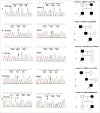Sequence CLCN1 and SCN4A in patients with Nondystrophic myotonias in Chinese populations: Genetic and pedigree analysis of 10 families and review of the literature
- PMID: 27415035
- PMCID: PMC5279883
- DOI: 10.1080/19336950.2016.1212140
Sequence CLCN1 and SCN4A in patients with Nondystrophic myotonias in Chinese populations: Genetic and pedigree analysis of 10 families and review of the literature
Abstract
Myotonia congenita (MC), paramyotonia congenita (PC) and sodium channel myotonias(SCM) were belonged to Non-dystrophic myotonias, in which muscle relaxation is delayed after voluntary or evoked contraction. These diseases can not be simply distinguished only based on symptoms and signs but also on genetics: more than 100 mutations in the CLCN1 gene have been associated with MC, while at least 20 mutations in the SCN4A gene have been associated with PC and SCM. Most of these genetics studies have been conducted outside China, only several MC, PC, and SCM families accepted gene scan were reported in China. Therefore we analyzed genetic mutations in CLCN1 and SCN4A in 10 Chinese families clinically diagnosed with Non-dystrophic myotonias. Our result revealed 12 potential disease-causing mutations(3 mutations were novel) that were present in the probands and affected family members. We also reviewed all available literature on mutations linked to these 3 disease in Chinese populations. Our results may help identify genetic determinants as well as clarify genotype-phenotype relationships.
Keywords: CLCN1; SCN4A; myotonia congenita; paramyotonia congenita; sodium channel myotonias.
Figures



Similar articles
-
Clinical and molecular characteristics of myotonia congenita in China: Case series and a literature review.Channels (Austin). 2022 Dec;16(1):35-46. doi: 10.1080/19336950.2022.2041292. Channels (Austin). 2022. PMID: 35170402 Free PMC article. Review.
-
Functional and Structural Characterization of ClC-1 and Nav1.4 Channels Resulting from CLCN1 and SCN4A Mutations Identified Alone and Coexisting in Myotonic Patients.Cells. 2021 Feb 11;10(2):374. doi: 10.3390/cells10020374. Cells. 2021. PMID: 33670307 Free PMC article.
-
A case of non-dystrophic myotonia with concomitant mutations in the SCN4A and CLCN1 genes.J Neurol Sci. 2016 Oct 15;369:254-258. doi: 10.1016/j.jns.2016.08.030. Epub 2016 Aug 13. J Neurol Sci. 2016. PMID: 27653901
-
Sequence CLCN1 and SCN4A genes in patients with nondystrophic myotonia in Chinese people.Medicine (Baltimore). 2022 Jul 22;101(29):e29591. doi: 10.1097/MD.0000000000029591. Medicine (Baltimore). 2022. PMID: 35866763 Free PMC article.
-
Guidelines on clinical presentation and management of nondystrophic myotonias.Muscle Nerve. 2020 Oct;62(4):430-444. doi: 10.1002/mus.26887. Epub 2020 May 27. Muscle Nerve. 2020. PMID: 32270509 Free PMC article. Review.
Cited by
-
Neck muscle hypertrophy in paramyotonia congenita caused by a missense variant in the SCN4A gene (p.Val445Met).Acta Neurol Belg. 2025 Jul 25. doi: 10.1007/s13760-025-02849-1. Online ahead of print. Acta Neurol Belg. 2025. PMID: 40707763 No abstract available.
-
Clinical and genetic analysis and literature review of children with myotonia congenita due to CLCN1 mutations.Ital J Pediatr. 2025 Jun 9;51(1):183. doi: 10.1186/s13052-025-02028-1. Ital J Pediatr. 2025. PMID: 40490814 Free PMC article. Review.
-
Myotonia Congenita: Clinical Characteristic and Mutation Spectrum of CLCN1 in Chinese Patients.Front Pediatr. 2021 Nov 1;9:759505. doi: 10.3389/fped.2021.759505. eCollection 2021. Front Pediatr. 2021. PMID: 34790634 Free PMC article.
-
The Clinical, Myopathological, and Genetic Analysis of 20 Patients With Non-dystrophic Myotonia.Front Neurol. 2022 Mar 8;13:830707. doi: 10.3389/fneur.2022.830707. eCollection 2022. Front Neurol. 2022. PMID: 35350395 Free PMC article.
-
Clinical and molecular characteristics of myotonia congenita in China: Case series and a literature review.Channels (Austin). 2022 Dec;16(1):35-46. doi: 10.1080/19336950.2022.2041292. Channels (Austin). 2022. PMID: 35170402 Free PMC article. Review.
References
-
- Kubisch C, Schmidt-Rose T, Fontaine B, Bretag AH, Jentsch TJ. ClC-1 chloride channel mutations in myotonia congenita: variable penetrance of mutations shifting the voltage dependence. Hum Mol Genet 1998; 7:1753-60; PMID:9736777; http://dx.doi.org/10.1093/hmg/7.11.1753 - DOI - PubMed
-
- Lee SC, Kim HS, Park YE, Choi YC, Park KH, Kim DS. Clinical Diversity of SCN4A- Mutation- Associated Skeletal Muscle Sodium Channelopathy. J Clin Neurol 2009; 5:186-91; PMID:20076800; http://dx.doi.org/10.3988/jcn.2009.5.4.186 - DOI - PMC - PubMed
-
- Matthews E, Fialho D, Tan SV, Venance SL, Cannon SC, Sternberg D, Fontaine B, Amato AA, Barohn RJ, Griggs RC, et al.. The non-dystrophic myotonias: molecular pathogenesis, diagnosis and treatment. Brain 2010; 133:9-22; PMID:19917643; http://dx.doi.org/10.1093/brain/awp294 - DOI - PMC - PubMed
-
- Cannon SC, Brown RH Jr, Corey DP. Theoretical reconstruction of myotonia and paralysis caused by incomplete inactivation of sodium channels. Biophys J 1993; 65:270-88; PMID:8396455; http://dx.doi.org/10.1016/S0006-3495(93)81045-2 - DOI - PMC - PubMed
-
- Nurputra DK, Nakagawa T, Takeshima Y, Harahap IS, Morikawa S, Sakaeda T, Lai PS, Matsuo M, Takaoka Y, Nishio H. Paramyotonia congenita: from clinical diagnosis to in silico protein modeling analysis. Pediatr Int 2012; 54:602-12; PMID:22507243; http://dx.doi.org/10.1111/j.1442-200X.2012.03646.x - DOI - PubMed
MeSH terms
Substances
Supplementary concepts
LinkOut - more resources
Full Text Sources
Other Literature Sources
